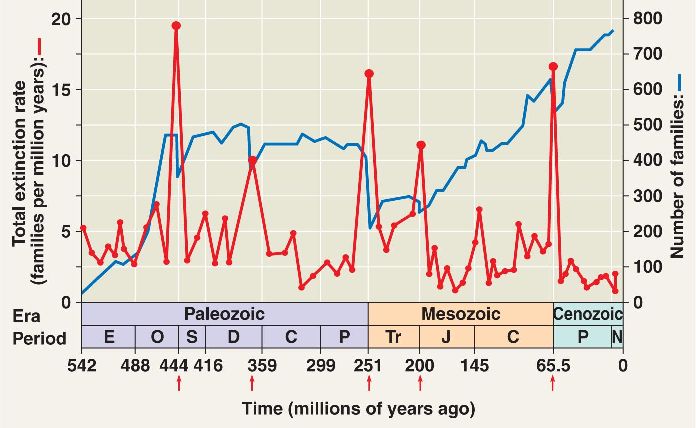 |
| The red line represents the rate of extinction. The major deviations indicative of the Big Five are labelled |
Those five data points are now the basis for the concept of the 'Big Five' mass extinctions, each of which has wiped out 70% of species or more. Their causes are wide-ranging, but each has drastically changed the biological composition of the planet. Now a sixth may have been identified.
The Big Five are currently represented by the extinction events during the late Ordovician and Devonian, the end Permian, Triassic and Cretaceous periods. They are accompanied by a spate of smaller extinction events - fluctuations in the background rate of extinction, but not deserving the title of 'mass' extinction. One such event was the Capitanian crisis during the middle Permian. Known from a sudden decline in brachiopod diversity, rocks documenting the extinction came from equatorial latitudes, it was not considered a global event.
 |
| The limestone beds of the Kapp Starostin formation in Spitzbergen, dating from the middle Permian 262 million years ago |
A research team led by David Bond from the University of Hull conducted a study of 262 million year old rocks from the Kapp Starostin formation, Spitzbergen. Dating from the middle Permian, they formed at a high latitude and preserve the same rapid brachiopod decline seen in the equatorial rocks.
This provides the first evidence that the Capitanian crisis may have occurred on a global scale. Geochemical studies of the Kapp Starostin rocks showed that widespread oxygen depletion, or anoxia to give the proper term, may have been the cause of the crisis, combined with the loss of carbonates from the ocean due to acidification.
Brachiopods were shelled organisms and the lack of marine carbonates would have hindered shell formation, resulting in their decline during this time. On the basis of its new-found global scale the Capitanian crisis could be considered a mass extinction, meaning the Big Five should change to the Big Six.
The statistical definition of a mass extinction is the loss of 70% of species across a certain number of families. Future studies of biological diversity before and after the event will determine if the Capitanian crisis stands up to this definition.